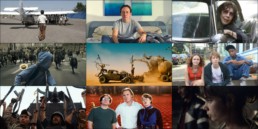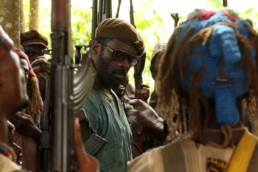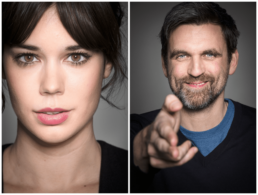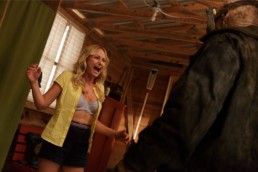Nelson's Top 10 Films of 2015
"Perhaps more than any other year, 2015 represents the industry facing growing pains with fewer people going to theaters yet more movies being created than ever before. Because I saw more movies this year than I have in the past, this list represents a more unusual curation of cinema".
What we consider to be the best of this year represents a combination of the movies that had the greatest emotional impact on us, matched with movies that felt innovative or groundbreaking. Here are the films Nelson considers to be this year’s best:
Honorable Mentions (alphabetical order)
Carol – A slow-burning romance set amidst a fascinating era of the US
Son of Saul – Exhausting yet essential storytelling utilizing all that film can bring to tell one horrific story that represents the larger Holocaust experience.
Steve Jobs – The Boyle/Sorkin duo created a biopic as innovative as the man himself
Where to Invade Next – Michael Moore’s least controversial movie yet perhaps his most thought-provoking
Wild Tales – Argentina’s raucous anthology of short films perfectly juxtaposed together

10. Cartel Land
2015 is a banner year for documentaries, and I have been fortunate to see more this year than in any years past. Cartel Land is both a display of cinematic bravery and also a master craft in non-fiction storytelling. Director Matthew Heineman gains unprecedented access to numerous facets in the complex war on drugs. He was a firsthand witness to countless firefights and stayed calm by focusing on his camera work and not the mayhem he was witnessing. With each person he follows, he displays characters who blur the artificial line between good and evil. It is an exposé without feeling like a history lesson. I thoroughly enjoyed Sicario, the other high-profile US-Mexico border movie this year, but I found Cartel Land to be even more engrossing and morally ambiguous than its fiction counterpart. This is a documentary that will remain a powerful experience for viewers years after current conflicts dwindle because of the larger themes it displays.

9. We Come As Friends
Every year the Academy narrows down to 15 documentaries before choosing 5 that receive an Oscar nomination. The biggest surprise on this year’s list of 15 (out of roughly 100 eligible) was Herbert Sauper’s South Sudan documentary We Come As Friends, which I first saw at Sundance all the way back in January 2014 before seeing it again when it got a US release in August 2015. Despite Oscar predictors all putting this as the least likely of the 15 to receive a nomination, there is a reason it made it that far amongst bigger players.
Using as little exposition as possible in a genre/medium usually dependent on it, Sauper uses heavily symbolic imagery to depict the chaotic situation in the world’s youngest (and possibly most unstable) nation. The metaphor of alien invasion is pertinent through the film as the subject is less the country’s inhabitants and more about the people invading the country and viewing it as a foreign place incapable of independent survival. What we see is blatant modern colonialism with similar horrific consequences to the past.
The same subject in another filmmaker’s hands could have been a very dry documentary about all that’s bad in the world, but this is a film that achieves discomfort through its symbolism and subtle displays of the situation. South Sudan is not a country at the forefront of the media and, therefore, this film is of utmost importance in showing something we otherwise wouldn’t see. It's rich symbolism and rare method of displaying a conflict make it a cinematic feat worthy of being among the best movies of the year.

8. Love and Mercy
Like Steve Jobs, Love and Mercy turns the biopic on its head and achieves a newfound approach to depicting the life and experience of someone notable, in this case, Beach Boys leader Brian Wilson. Having 2 different actors play Brian Wilson sounded a bit like a gimmick, but Paul Dano and John Cusack both become Brian Wilson without coming across as an imitation. Like a classically great performance, we never forget it's these actors, but we're never distracted by it either.
The fact that their stories never actually cross over and that the characters in the past never make it into the future is brilliant in that it suggests just how disjointed Wilson's life had become in his later years. This is a successful way at capturing a character's life that I've never seen work so well. There is a clear effort toward every aspect of the film in telling this story: costuming, set design, camera movement, blocking, etc. All these elements are so poignantly utilized to elevate the conditions Brian Wilson experiences. And the sound design, fittingly, is wonderfully employed to put us in Wilson's situation.
After I saw the film, I stalked the IMDb of the team that made the film: Bill Pohlad, Oren Moverman, Atticus Ross, Ann Ruark, and many more creatives came together to make a passion project in the best possible way: it isn't indulgent, it is inspiring and emotionally moving. This is a film that can be appreciated by the die-hard fans and the newly initiated. I am thankful that there is still room in the movie business for people to come together and make something special they clearly wanted to share on screen.

7. Me and Earl and the Dying Girl
Surprisingly (I imagine in part due to the morbid title) this festival awards winner didn’t find a large audience in theaters the same way fellow Sundance alums Little Miss Sunshine or Whiplash did. Yet in my experience, this is a film that perfectly walks the line between comedy and drama. It embraces the indie teen genre that’s become a cliché and still squeezes out new material, thanks to some great characters, deliberate and intriguing filmmaking, and most of all emotional depth. Me and Earl brings up the theme of death in a way that isn’t drab nor is it mocking. It is relatable and emotional yet still takes risks and tries new things with cinema. And of course, it’s actually a comedy, despite how the title sounds, and it’s a funny one at that. The result is a film that may seem easy to disregard as a teen dramedy, but, in fact, is layered and unique enough to be worthy of critical acclaim. As an added bonus for film lovers, it has some of the best callbacks and spoofs of classic movies I’ve ever seen.

6. White God
From the opening shot of 300 dogs chasing a girl on a bike, it’s clear this is going to be something unique. White God is essentially Oliver Twist with a protagonist who is a canine. A major chunk of the movie features only dogs on screen, and thanks to some expert trainers, they come across as actual characters instead of glorified props. The fact that this film manages to cross a foray of genres, incite an emotional response from non-human protagonists and on top of that also be an allegory for the lower-class Hungarian experience makes it a complete work of art. It’s graphic depiction of dog fighting is off-putting for some but a reality that needs to be faced. The director is aware that viewers are even more disturbed by animal violence than they are of humans, so he creates empathy through his animal protagonists that symbolize a human condition. On top of this, I acknowledge that there is depth in this film that I haven’t even seen because I don’t know the nuances of Hungarian language and culture. Lastly, the title, an obscure reference to the confusing dynamic between dog owners and their pets, seals this film as one of the most intricate and fascinating cinema experiences of the year.
5. The Revenant
One of the best parts about seeing an entire director’s filmography is that with the top-tier auteurs, patterns start to emerge in their thematic choices. Alejandro G. Iñarritu has made 6 films in 15 years, and with the exception of Birdman, there is a clear theme of faith and spirituality underlying his work that makes every one of his movies that much more compelling. The Revenant is undoubtedly his most ambitious project to date, and perhaps his biggest departure from his early style, yet it profoundly features the numerous themes that define the director’s palette. Pay extra attention to his portrayal of religion: it elevated my enjoyment of the film immensely. At the surface, it is an action-packed western adventure that engulfs the viewer in the world of the frontiersmen and the constant challenges they endured, but Inarritu’s brilliance comes from the subtle details that are sprinkled all throughout. Leo and Tom Hardy, a perfectly matched protagonist and antagonist, both deliver knockout performances despite very little dialogue. Many film buffs will praise the cinematography and the technical prowess of the project. It’s safe to point out that the behind the scenes work here is flawless, yet it only matters if the story is compelling to watch. Fortunately, it is: this is a rare opportunity to see cinema fire on all cylinders while telling an entertaining narrative. This is a balance of spectacle and entertainment that makes cinema so engaging in the first place.

4. Room
Of the numerous movies circulating Oscars and other awards this year, my favorite is by far and away Room. Best viewed with as little information as possible (the trailer gives away far too much), it is an emotional experience not easily forgotten. Brie Larson, whose work in Short Term 12 prior to this was similar yet equally phenomenal, plays the mother of Jack (Jacob Tremblay) and the two of them live in a room and do not leave. The journey that they go on is grounded in the powerful relationship seen between a mother and son despite the situation they are in. It’s an unconventional narrative split into two distinct parts. When the first part ends it feels like the ending of a movie, yet it then transitions to a more nuanced dramatic exploration in the second half. There isn’t anything particularly flashy, and the craft is all extremely subdued in exchange for focusing on these characters. When your subjects are strong enough, as they are here, you can make a great movie with this style. This is a film that represents the pinnacle of dramatic filmmaking and thankfully is receiving the awards attention it deserves.

3. Grandma
At a brisk 78 minutes, Grandma packs in some of the best movie material from the entire year. Hidden within the deceitfully simple premise is some of the most layered and fun storytelling I’ve seen and plenty of humor and sincere laughter. This is a movie that manages to cover the board in terms of being funny, endearing, and poignant. Much credit is given to writer/director Paul Weitz, who expertly crafts such an efficient and entertaining story. The cast elevates the film to another level: Lily Tomlin weaves in plenty of her actual self and still creates a character so engaging to watch and while landing every single joke in the movie. Her supporting cast is almost entirely all-stars: Sam Elliot, Laverne Cox, John Cho, Judy Greer, and Marcia Gay Haden, who each make the absolute most of their limited screen time and are perfectly cast. These types of comedies are often overlooked for flashier counterparts, yet Grandma is more endearing and thought-provoking than many of the more prestigious awards movies. I wrote an article earlier this year about how the film revitalizes the pregnancy genre and provides a point of view that previously wasn’t seen on screen. With that, it provides the largest wealth of dimensional female characters while mainstream movies notoriously sideline women’s roles. For both its heart and humor, Grandma cannot be missed.

2. Mad Max: Fury Road
Normally, blockbusters are saturated, safe, and meant to be appealing to everyone, but nothing is easy to digest about Fury Road. It is a wild unrestrained ride of non-stop mayhem; in other words, it is an absolute blast. Jumpstarting a franchise that nobody thought needed another entry, and most people born after 1990 have never seen, George Miller reinvigorated his fable to new heights. If every franchise reboot felt as fresh as Fury Road, then I could get behind the industry’s obsession with sequels and reimagining old intellectual properties. Miller lets the action and the nuances inform the viewer of the post-apocalyptic world. Dystopias are all the rage in the wake of The Hunger Games, but none have the level of detail and sophisticated, nasty madness that this movie displays.
The top-tier movies elevate beyond just watching and come across as an experience, and this is one of those films. Every element here hits on all cylinders. Funnily enough, this is the second year in a row where I’ve had a movie on my top 10 list with Tom Hardy driving for the entire movie (last year was Locke) – I would consider him to be my favorite working actor at this point thanks to his versatility and the types of movies he ends up in. I love a great action movie and can’t remember the last time action sequences or chase scenes felt so fresh and alive. Miller used stunt performers from Cirque du Soleil among other places and spent months shooting on multiple cameras in the desert; the results pay off, and he’s created one of the finest action movies of the decade.

1. Victoria
Despite the fact that the biggest selling point on this movie is that the entire film is one uninterrupted shot, Victoria is more than just a movie all in a single take. For the first half of the film, director Sebastian Schipper borrows from the styles of Richard Linklater to introduce us to the film’s protagonists, lonely partier Victoria and four men she encounters on her way out of a club. The film works so well because we’re given a great deal of time with the protagonists in the first half with the authenticity that makes us feel like we’re among them. When the film escalates dramatically in the second half, it is believable (even if it’s an extreme circumstance) because we’ve spent so much time with them and want to root for them. This is a film with thrillingly tense sequences, and also moments where I was laughing the way I might with a group of friends. Schipper told his cinematographer to shoot the film like a war photographer: don’t anticipate what’s going to happen, let the action guide you. The result is more focused on the sum of the film than any particularly special shot while still making room for a few outstanding images amongst the chaos.
The fact that this film has both the most daring cinematography of the year on top of a compelling set of characters and memorable sequences makes it a film that has everything firing on all cylinders. Victoria is not the type of film that garners awards attention at the end of the year, but for me is the cinematic experience that invigorated me more than any other movie I saw this year. For the reasons above and so many more, I consider this to be the best film of 2015.
Review: 'Where To Invade Next'
Let’s start with the title: it’s a complete bait and switch. There is an indication from this title and from the movie’s opening that this is a movie about the US Military and their dominance worldwide. You’d never guess it, but this movie has almost nothing to do with this, a breath of relief as you can imagine there are only so many times we can fathom all the negative elements of the trillion-dollar US war business.
Instead, Moore’s latest film, Where To Invade Next, is actually an optimistic documentary, a bit of a paradox in the world of news related docs. The film is a series of vignettes showing Moore traveling to, or ‘invading’, different countries on a hunt for what they are doing well and for ideas to take back to the United States. While his choice of countries is unfortunately very Euro-centric, the results are surprisingly effective. In every country, Moore chooses a specific topic to dive into. In France, it’s food in schools. In Italy, it’s work vacations. With each country, Moore is trying to show how systematically horrible our current system is and what it has the potential to be. The food in our school cafeterias is what is nourishing young people but is treated as an afterthought and the results are pretty gross. In France, food is seen as part of their education, so eating lunch is given major a level of respect as a way to teach kids how they’ll eat well for the rest of their lives. This is one of the many fantastic examples that Moore finds in each country.
Moore isn’t focused on shaming America though: he’s interested in showing how fantastic these other countries are when in action.
The root of all of these problems comes from the mismanagement of money, the greed of for-profit schools and public buildings such as prisons, and more that many moderately-educated viewers will know about. Moore isn’t focused on shaming America though: he’s interested in showing how fantastic these other countries are when in action. Of course, any documentary has the tendency to be biased and with Where To Invade Next running at only 110 minutes, Moore must paint countries with broader strokes. However, he does a great job of making sure any skepticism is answered. For example, after highlighting one particular school or prison, he often will show a second more extreme example that confirms the point he is making. Moore is a polarizing character, but he’s a master of the craft. He knows how to make his points, funny or serious, using the tools at his disposal.
It’s been a fantastic year for documentary, in large part due to the number of working documentary filmmakers who have new material this year: Alex Gibney (Going Clear and Steve Jobs), Kirby Dick (The Hunting Ground), Davis Guggenheim (Malala) and Moore, among others. Each of these prolific directors has a signature style which they don’t stray far from, but in every case it works to their personality and subject matter. All are in contention for the Best Documentary Oscar. While Michael Moore’s latest isn’t particularly topical compared to some of his other work, it invites Americans to recognize that perhaps we need to look at other countries as models for how to improve our current system. His final revelation not only is fascinating but ties the whole film together. For any American interested in the future of our country, look to this film as a guide to some positive possible directions.
Where To Invade Next opens at ArcLight Hollywood on December 23rd with a national release February 12, 2016. Rated R for language, some violent images, drug use and brief graphic nudity.
https://www.youtube.com/watch?v=r4JJvfrkH3M&feature=youtu.be
Review: 'Can You Dig This'
Right off the bat, this is exactly the type of story that a documentary can portray so much better than any other medium. Within Southern L.A. are numerous underprivileged communities most of which are stuck in a cycle of poverty and criminal activity. Delila Vallot’s documentary debut, Can You Dig This, which fittingly premiered at the L.A. film festival earlier this year, is a counter argument to the negative stigma surrounding impoverished areas, displaying the potential growth that this community can have.
A large handful of protagonists is shown here, giving a great variety of ages and backgrounds and relationships with the garden. No character is short on emotionally connecting stories, which makes the entire film flow extremely well without any flack. The running theme is that many of the people in these urban gardens have backgrounds in gang or criminal behavior, as well as non-existent access to healthy food. Gardening is a radical statement far against the status quo of what’s expected. One gardener, Ron Finley, has become the most famous of the group for inspiring urban gardening nationwide. His poignant statements of wisdom ground the film, including his observation that within his neighborhood in Compton there are 3 grocery stores, and over 75 fast food restaurants. Finley says, “Some people call these food deserts. I call these food prisons because you can grow stuff in a desert.” Yet when we meet him, the city is trying to fine him for growing sidewalk gardens where it’s supposed to be plain grass. As he points out, grass takes double the amount of water and doesn’t produce food.
So often these communities become the subject of frustration and scrutiny when in fact there are stories of inspiration blooming within.
The other four characters each have their own level of heart and spirit compellingly documented. Quimonie is a girl under the age of 10 with an already blooming garden, which she started to help her family. This little girl, along with her 4 younger sisters, has so much heart and humor perfectly captured in the project; her close relationship with her father ends up being one of the most heart-warming elements of the film. Vallot sneaks in some character moments that allow us to truly love watching her on screen.
On the other end of the age spectrum is Hosea, an ex-convict who served in prison for nearly half his life and is now in a halfway house. Together with another ex-con named Henry, these two men, both over 70 and with a major chunk of their life behind bars, revitalize a space in their house and transform it into a garden. Seeing these old-timers, who would be considered criminals, connect with the earth in such a harmonious way, quietly displays an alternative to the abuse that our criminal system generates. The other two protagonists, Spicy and Kenya, also have stories equally as rich, compiling into a perfect display of five unique types of gardeners.
So often these communities become the subject of frustration and scrutiny when in fact there are stories of inspiration blooming within. The film’s director never establishes how involved they are with the characters, one of the film’s only weaknesses, but masterfully shows a full range of dynamic characters whose stories naturally progress over the runtime. But what makes Can You Dig This work even better is that these characters represent archetypes for community members who aren’t often associated with gardening, but could easily get involved and find a better way of living. While being a compelling character piece instead of a blatant message movie, Can You Dig This inspires not only the food desert communities but all urban dwellers, to consider the positive impacts that can happen when one starts a garden.
Can You Dig This is now playing on all major VOD platforms.
https://vimeo.com/142570527
'Beasts of No Nation' Review: Child Soldiers Show the Horrors of War
Because we don’t see films in a vacuum, any story that carries social or political weight requires an extra step of scrutiny. This isn’t to dampen the experience, but to verify the authenticity of a cinematic experience. "Beasts of No Nation" is based on a novel carefully compiling numerous true accounts merged into the story of a child solider. An element worth dissecting is that this story does not take place in a specific location, instead opting for an unnamed African country. This has two potential effects. On the positive side, it makes the story and experience universal, as similar situations have happened in numerous central and western African countries. On the contrary, by not making the setting any one country in particular but a generic “Africa,” it continues an unfortunate American way of painting a massive continent with a single brush stroke. For as unique a story as this is, it only furthers the trend in viewing Africa as a country instead of a massive continent with numerous truths and stories within. This is a debate I don’t know the answer to, whether the universal nature of the story trumps its broad stroke of the continent.
What about the movie itself? The story structure in "Beasts" is that of "Pinocchio" or more recently, "12 Years a Slave" in terms of an innocuous individual getting swept into something horrific. In the beginning, our protagonist, Agu (Abraham Attah), is a boy living with a loving family. As civil war and unrest infiltrate their lives, it isn’t long before Agu is separated from his family and driven into a journey of the horrific world of warfare where children fight alongside adults as soldiers. After everything he’s been through, it isn’t hard for the rebel army to persuade him into actually wanting to be a solider (even though he doesn’t have another choice).
https://www.youtube.com/watch?v=p5N_3ki7cio
At the top of the army is the unnamed Commandant (Idris Elba). You’d expect this character to be a single stroke of evil, but he isn’t. He’s charismatic, he expresses interest and care in his soldiers, and he gives them a reason to fight. It’s even more terrifying that he is impressionable and even affable than if he were a terrorizing menace: in this world, he makes what they are doing seem okay, even though it is as nightmarish as you might anticipate.
In the middle of the film, we see this unsettling balance between the camaraderie and brotherhood of an army, in the backdrop of an absolutely sickeningly war. Much credit is given to the soundtrack, which is one of the best in recent memory. Because this is not a film with a plot or a driving story, but is more of a journey through the madness, it’s a film that evokes you to think about the story in a larger context. This also makes it arduous to endure through (and its runtime is well over 2 hours), but that is undoubtedly the intention. It is not a film for the light-hearted, nor would it ever be. Alas, although this story is fiction, this has been crafted to highlight the many facets of the child soldier journey.
Director Cary Fukunaga is also the cinematographer, therefore the camera work here is always on display. Numerous tracking shots expose the grandiose artistry at work and adds to the hypnotic nature of this warfare. The static shots are equally well composed. A provocative opening shot challenges the viewer to think about what they are watching, and how they are watching it. Is this entertainment? As affluent viewers (especially those on Netflix), how is this to be viewed? In this case, it is as important as the film itself to think about the social impact of this film. How can this film benefit a tragic, ongoing situation in a continent many Americans know little about is a question worth a further discussion. I don’t have the answer, but I urge anyone who sees this film to go into "Beasts of No Nation" looking for their answer to this question.
"Beasts of No Nation" opens at the Landmark this Friday.
Laia Costa and Director Sebastian Schipper on 'Victoria'
One City. One Night. One Take. This is the premise of the latest film to garner Oscar buzz–Victoria, a groundbreaking crime drama about one young woman's late night Berlin adventure with four strangers. We chat exclusively with German-born Sebastian Schipper, whose previous acting credits include Run Lola Run and The English Patient, and the entrancing Laia Costa, who won Best Actress for her role as the title character at the German Film Awards. The interview, or shall I say, conversation, is not only lively but extremely insightful. We talk about Schipper's "punk rock" attitude, disregarding the film industry's stereotype of creating "precious ideas" and how rehearsal is "bullshit." We begin:
I saw Victoria at LA Film Fest and went in completely blind, other than knowing it was shot in one take.
Sebastian Schipper: That's great, that's always the best. When the guys who did publicity for Victoria at the Berlin Film Festival popped in the DVD, they told me they didn't know anything about it. They were like, 'Oh this is just a walking, talking film before sunrise.. a little gritty, darker' and then they were like, 'Ohhh!' Haha! I'm glad, I wish I could give this kind of experience to everybody who watches the film.
In marketing the film, how do you find the line between selling the incredible work it is but not giving away the experience?
Sebastian Schipper: You can't control it. People are going to read what they're going to read and know what they're going to know. The one thing I know is I want them to see the film because I believe whatever they're expecting is going to be a little different. Maybe it'll be hugely different actually. Even if you know the two big plot points, I'm pretty sure you're going to find out that might be the least important thing about this film.
What was so incredible for me is that for the first hour or so, you're getting to know these characters. Getting so much time to develop the characters before tension starts to rise, you feel like one of them in a way.
Sebastian Schipper: Yeah!

How did you make this film- specifically, how did you plan out the film's beats and blocking before filming?
Laia Costa: We spent a month in every location. It was a very creative process because there was no script per se. I really loved Sebastian's rules, you cannot repeat any sentence or action, and that gave us a lot of power to discover our characters and the situations and make the story richer every time. Then we did it in three one takes. By then we knew our characters' backgrounds and roles. And then we did it in the one take. My favorite take was the second one actually. One night Frederick Lau and I were very drunk and we were like, "Our best take was the second! We don't like the third one!' But then we saw the third one and it was amazing too. I am really happy with the three of them.
Sebastian Schipper: I don't believe in rehearsing with actors on a film. We would only really spend one day talking about a scene. What's Laia going to do one month before shooting in some rehearsal space? It's total bullshit. I was an actor, and as an actor, deep down you're like I gotta do this for the director but for me, I'm going to do it the day it is going to happen.
There are shots that are deliberate, my favorite of which happens in the hotel. I think that's why the one take works so well is because within the one take are these types of shots.
Sebastian Schipper: That shot was a decision. Here is one thing that I think is very characteristic to this film- I wanted to get away from the precious ideas and I think sometimes making movies is too much about the precious ideas, like the "great line" or the "great shot". I love great lines and I love great shots but sometimes when I watch a film, I feel like 'Oh, this is a great idea' and it takes me out of the film. That's one thing. I don't want ideas, I want a great fucking film. I think we have a culture now, the smartphone culture, where everybody creates something small every day and shares it with everybody. We share pictures, quotes, this is my food today... haha. I feel like this culture is jumping into the making of movies; like you have a hundred ideas and that's your movie. I think it's the other way around, I think you have to tap into something tremendous and from that point stuff is going to come. There are great lines and images in this film, but they all spring from some deep, slow, cold undercurrent.
I said to my cinematographer Sturla [Brandth Grøvlen], 'You don't know anything, you're a war photographer with your camera with this girl in this club, and you follow her. You just hang on.'
I think we watch films with our nervous system, with our heart and brain. You feel a film. So, the most important thing is that you are enabled to feel it. I said to my cinematographer Sturla [Brandth Grøvlen], 'You don't know anything, you're a war photographer with your camera with this girl in this club, and you follow her. You just hang on. Please don't anticipate what's happening next because if you know, the audience can tell and that would inform their spine that this was make believe.' Of course you know up here (points to head) that this is a movie, but the important thing is that your nervous system doesn't know, and that enables you to get on the trip.

I like the war photographer comparison, it's like being a documentarian being ready for the action.
Sebastian Schipper: That's actually something I liked about Sturla, he shot documentaries before. He's young and has to carry around the camera for 2+ hours and he's a great artist.
Laia Costa: Yeah, he's amazing.
What other crew members were following the action during filming?
Laia Costa: For me, no one! I couldn't see anyone, but was later told there were people on the roof, and I didn't know that.
Sebastian Schipper: Sometimes the sound guys did boom the film and there was a point when I wanted to forbid it.
It's unusual for American audiences to see a foreign film in English.
Sebastian Schipper: Berlin has become the place for a lot of young people in their twenties to go to. People from New York are in Berlin, same with people from Austraila and Spain.
Laia Costa: Everyone talks in English. I was there for three months and I was talking to everyone in English. I have friends who have been working in Berlin for five years and they don't speak German at all.

What has it been like getting Victoria out to audiences?
Laia Costa: It's a bit tiring doing all of this promotion. When the journalist is as handsome as you, it's fine, haha.
Sebastian Schipper: If it's a conversation, it's great. It makes all the difference in the world. With the making of Victoria, I tried to get out of the box of how you're supposed to do things. Sometimes now while promoting it, I feel like a student again. I would rather just have the film be the film. I've done over 200 interviews and if it's a conversation [rather than Q & A], it's great. Sometimes it's like you have to answer for what you did, and what we did was punk rock. One part of me wants to show up [to interviews] totally drunk and give the finger all the time..haha. Not that that's the spirit of the film or how we feel about it, it's just trying to get away from all the [questions].
For our review of Victoria, click here.
'Victoria' Review: This Single-take Film Will Blow You Away
This review originally ran on 6/16/15 during the LA Film Fest
Amidst the vast number of movies released each year, when the truly excellent pieces come along, they allow you to check both yourself and all of life’s ponderings at the door, and instead, fully embrace the world within the movie for the next few hours. "Victoria" is such a film that you enter into, and lose yourself to, the characters and the situation at hand.
The first quarter of the film introduces us to the titular lead, Victoria (Laia Costa), a lone party girl at a club who inadvertently finds the company of four similarly aged men. At first, she is reluctant, understandably so given the potential danger of being a single woman with this group, but soon we realize that they are harmless partiers looking for a jovial time and she is able to enjoy their company. For the remainder of the runtime, we see this group go from little better than strangers into situations that will dramatically bring them together, throughout the course of one night, all over the streets of Berlin.
If you’ve read anything else regarding this film, the first thing you’ll notice is also a huge selling point of this movie: the entire 140-minute film is done in a single, uninterrupted take. While the oner is a favorite throughout film history, most pieces that do this (including last year’s Best Picture winner "Birdman") edit multiple long shots to flow as one. This is not the case with Victoria, and the effect is dazzling. I did know this was going to be the case going in and was wary it might be a gimmick.
What really sells the film as a triumph is how the protagonists are all given range and authenticity that allows us something to root for.
In the end, I deliberately didn’t start my review focused on this because the end result is so much more than this effect. In this case, it surprisingly doesn’t dominate the film: there are fantastic character developments and each major scene swiftly goes to a new location, which helps the viewer to keep track of the unfolding story and not feel ephemeral as many one-take movies do. The camera work is a major element in the film’s success, and undoubtedly elevates the movie to a new level, but enough else is going on in this movie it doesn’t overwhelm the experience.
What really sells the film as a triumph is how the protagonists are all given range and authenticity that allows us something to root for. As the film progresses the pace quickens and situations get tense: it is because of the first half’s development that we are able to feel genuine emotion for each of these characters. There are thrillingly tense sequences, and also moments where I was laughing the way I might with a group of friends.
If you do manage to see the film, you’ll know exactly when these moments happen. Sonne (Frederick Lau), the male lead, shares some intimate and beautiful moments with Victoria and delivers an impeccable performance, but is equally matched by his rowdy pal Boxer (Franz Rogowski), who looks something like a more handsome version of the Mad Max war boys and plays the full range of character. The success in capturing these characters makes the film stand out so much.
Victoria won the cinematography award at the Berlin Film Festival and just played at LAFF. I do not know where its release will be from here, but you can count on me to be championing this triumph for the rest of the year. So rarely does a film sweep you off your feet and play the entire emotional spectrum in the way that Victoria does. I hope that many more audiences can share this fantastic cinematic experience that I’ve just had.
Victoria opens today at the Landmark Nuart, additional theatres on October 16th.
Review: 'The Final Girls'
This review ran on 6/18/15 during the LA Film Fest
Horror fans of the 1980’s grew up experiencing the terror of a new set of tropes and the mainstreamed depiction of grisly, campy violence. Many of these classics were terrifying experiences back then, but today’s audience grew up knowing all the clichés as just that. Therefore modern movie fans aren’t wooed by serial killers at summer camps or boogymen in closets. The current generation has a more cynical approach, and thus has birthed the satire horror film, the most notable installment being the widely cherished Cabin in the Woods.
With The Final Girls, director Todd Strauss-Schulson attempts to bring a new entry into this self-aware subgenre.
Max (Taissa Faramiga) is the daughter of 1980’s horror scream queen Amanda Cartwright (Malin Akerman) and is coming to terms with her mother’s absence in her life. One event leads to another and Max and her friends end up at a screening of the classic horror film her mother starred in, Camp Bloodbath, and in a Wizard of Oz-esque turn of events, Max and her friends get transported into the movie itself, and are forced to fend off the movie’s bloody killer as if they are in the movie themselves.
While the film truly has an original premise and gets plenty of mileage out of the movie-within-movie scenario, it ultimately gets weighed down by the mother-daughter relationship as a focal point.
Within the movie they must also deal with the fictional characters already in the movie, which happens to include the character played by Max’s mom (unaware that she is her daughter). It isn’t as confusing as it sounds, but the basic premise is a hybrid of horror comedy jabbing at the various slasher and general movie tropes, mixed with a sentimental mother-daughter storyline.
While the film truly has an original premise and gets plenty of mileage out of the movie-within-movie scenario, it ultimately gets weighed down by the mother-daughter relationship as a focal point. It was the writers’ intention for this to be more than just a horror comedy, but unfortunately every time the film deviates to the mother-daughter relationship, it loses major momentum. The relationship between the characters is genuine and authentic, but isn’t properly fused with an otherwise campy story. The result is segments that feel out of place compared to the rest of the film.
When it comes to the horror comedy itself, surprisingly, the final result is something that actually plays it much safer than it potentially could. When lined up next to other action comedies that emphasize the gore as part of the humor, Final Girls seems out of its league. Its strength then falls into its characters, which thankfully are unique and inspired enough to keep the film going.
The only exception (and I’ll admit I may be alone here) is Adam Devine, who frankly I just find increasingly less amusing with every new experience. Otherwise, the cast is a wealth of young talent who I can imagine will land bigger projects from here.
Finally, when it comes to the ending, which I will not spoil, the film has all the pieces to do something truly daring and twisting as most of the film does. Instead, the film takes its biggest twist and turns it into something rather safe, even erasing some of the unique decisions that the film establishes earlier. All in all, The Final Girls will entertain and provides a fun, self-aware movie going experience, but might not be as daring as the initial premise and concept suggests.
The Final Girls opens at The Vista in Los Feliz & On Demand this Friday.
https://www.youtube.com/watch?v=bwke66eJ4H8
Review: 'Steve Jobs'
The word ‘auteur’ is generally used to describe a director whose vision is clear enough to be recognizable. The great directors all fit into this category, but most screenwriters tend to play a more anonymous role. The exception is Aaron Sorkin, a screenwriter whose hyper-speed style and wall-to-wall dialogue is immediately recognizable in the best way possible. Five years ago, he won an Oscar for his unprecedented script on modern classic The Social Network. Although not working with Network’s director David Fincher, a similarly matched level of energy and bold protagonist dares his next project, Steve Jobs, to stand confidently alongside his other award winning work.
In the case of both films, Sorkin’s writing is met with a director whose style is equally vibrant. Job’s Danny Boyle may not have the fanboy following that Fincher has gathered, but from the film’s first moments there is little doubt that this is a “Danny Boyle” film. Boyle utilizes a vibrant array of images, quickly maneuvers between subjects, and manages to feel both macro and micro scale. Boyle has a few tricks up his sleeve as well that add a refreshing enough touch to make the film feel alive. The hybrid of writer from Social Network and director of Slumdog Millionaire and 127 Hours feels like a beautifully matched synthesis.
Because of the similarities to predecessor 'The Social Network', 'Steve Jobs' may not feel as enigmatic or fresh as the former film, but it’s entertainment and gripping narrative are enough to make it a must-see in its own right.
Perhaps the most daring element of this biography is, rather than telling the entire lifespan like a conventional biopic, the egomaniac genius of Jobs is distilled into three different chapters, each from different stages of his career. The film wastes no time trying to tell us information that we already know: it is entirely focused on the relationships Jobs had with his closest confidantes. Some fantastic decisions are made to distinguish each chapter, the most prominent being the decision to shoot using three different eras of cameras/film to match the progression of technology. Just one of many unique decisions that result in a more dynamic film.
Michael Fassbender, easily one of the greatest working actors we have today, tackles the character of Steve Jobs from the immediate get-go. He never feels disguised as the character, but instead embodies the classic approach where he is still very much himself within the spectrum of this incredible character. As is the case with nearly every element of the film, the ensemble of performers all show-up and deliver knockouts. Supporting cast members Kate Winslet, Seth Rogen, Michael Stulhbarg, and Jeff Daniels each get opportunities to deliver feisty discourse with Fassbender’s Jobs, and each is equally compelling. Since the triptych structure of the film allows for a very clear progression of character’s relationships, the arcs are more easily recognizable, but nonetheless well executed.
Because of the similarities to predecessor The Social Network, Steve Jobs may not feel as enigmatic or fresh as the former film, but it’s entertainment and gripping narrative are enough to make it a must-see in its own right. It is firing on all cylinders and captures the man behind so much of today’s world in a delectable manner. Because of the conscious decision to not cover the entire lifespan of Steve Jobs, but instead explore a series of dramatic relationships he had, the film is one that can stand beautifully beside Walter Isaacson’s book in that it only makes you want to learn more about the man instead of trying to encapsulate everything about him. Few influencers were as complex as Steve Jobs, and he is fortunate to have a film that does justice to the fascinatingly complex individual he is. For the numerous reasons listed above, Steve Jobs, a film equally attributed to Danny Boyle, Aaron Sorkin, and Michael Fassbender, is one of the must-see films of the year.
Steve Jobs opens Friday at the Landmark Theatre followed by a national rollout October 16th.
https://www.youtube.com/watch?t=1&v=aEr6K1bwIVs









